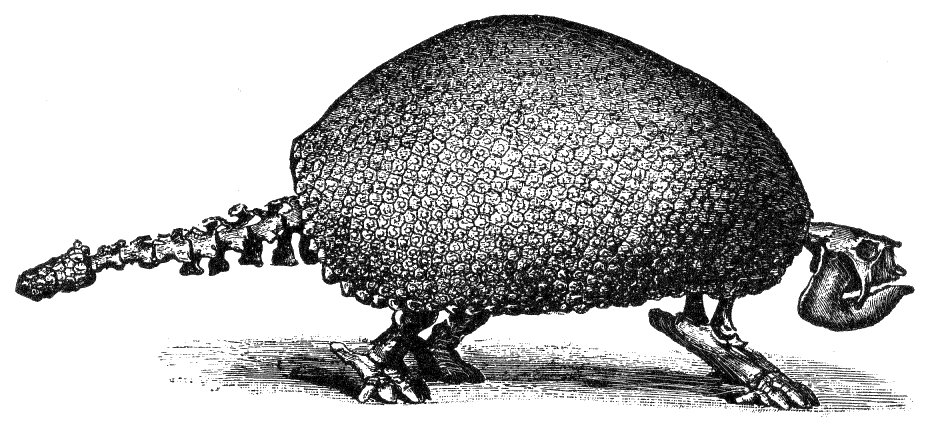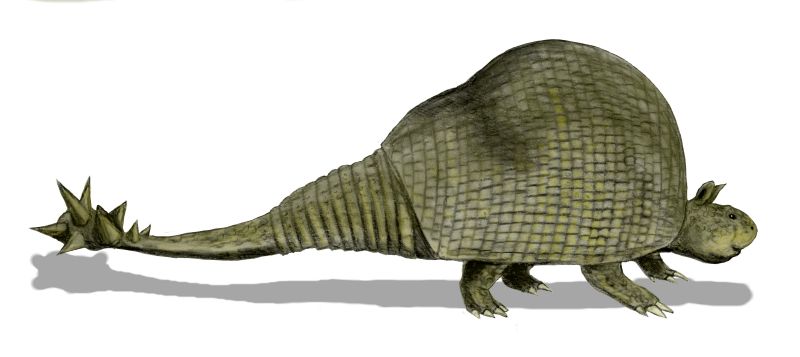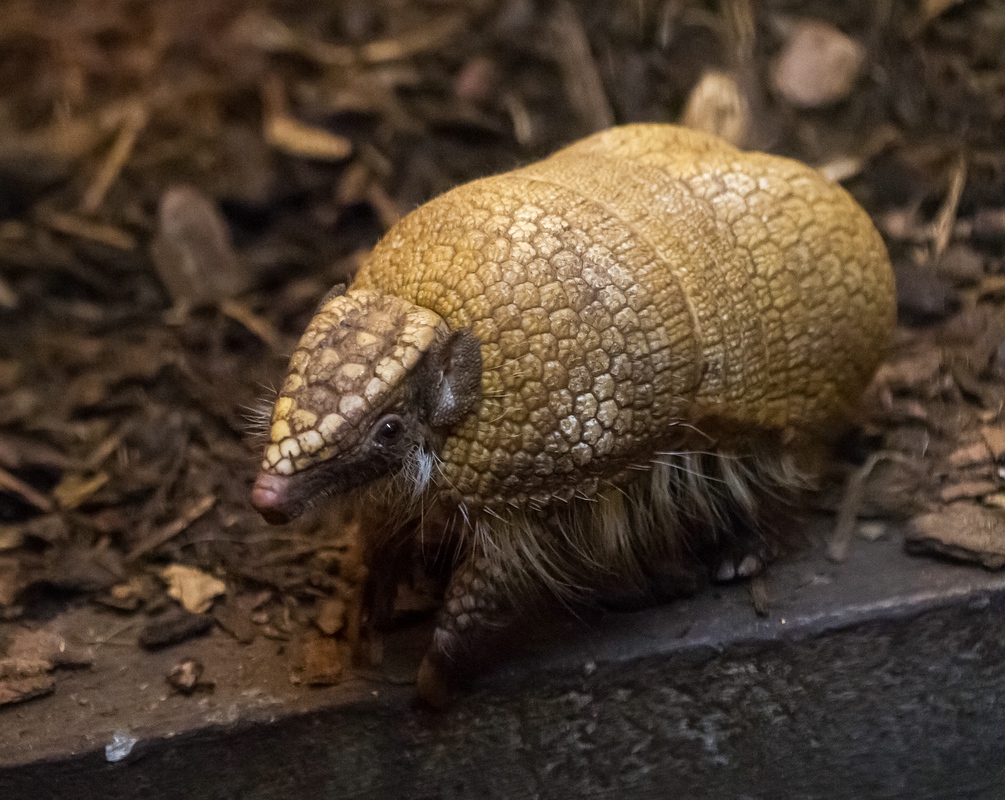Well-established by now on this blog is my love for and obsession with xenarthrans. So let it be a sign of my devotion to getting the upcoming issue of RNCSE out on time and full of awesome that I allowed not one but two xenarthran stories in the news to pass without comment. This then is the first of my xenarthran catch-up posts. The  story, which made the science news circuit in late February, stemmed from a short article in Current Biology (original is behind a paywall, but here is a summary). The superficial summary of the findings is that glyptodonts, my favorite group of extinct xenarthans, were giant armadillos. I’ll admit now that when I saw the headline I didn’t appreciate the newsworthiness of the result—didn’t we know that already? Thankfully, while trapped on a plane and cut off from the DC Eagle Cam for six hours the other day, I took the time to read the papers, because this is a very cool bit of research with, it turns out, a novel conclusion. Let’s dig in.
story, which made the science news circuit in late February, stemmed from a short article in Current Biology (original is behind a paywall, but here is a summary). The superficial summary of the findings is that glyptodonts, my favorite group of extinct xenarthans, were giant armadillos. I’ll admit now that when I saw the headline I didn’t appreciate the newsworthiness of the result—didn’t we know that already? Thankfully, while trapped on a plane and cut off from the DC Eagle Cam for six hours the other day, I took the time to read the papers, because this is a very cool bit of research with, it turns out, a novel conclusion. Let’s dig in.
Within the awesomesauce clade Xenarthra is clade Cingulata, which includes armadillos, glyptodonts, and pampatheres. Of these, only armadillos are still living. I am not very familiar with pampatheres (a blind spot in my xenarthran knowledge!), but from what I gather, they were a group of large animals (but not as large as glyptodonts) distinguishable from armadillos and glyptodonts by the structure of their shell. No one ever suggested that these three groups of animals were anything but closest relatives, and if you look at them, you’ll see why. However, just how they were related hasn’t been well resolved. Which two of the three were closest cousins? No one really knew. Anatomy could only reveal so much. It seemed that to get to the bottom of this xenarthran mystery, DNA would be needed.
But if you’ll recall, two of the three groups of cingulates are extinct, and fossils, while unquestionably valuable, are not a great source of DNA. (Here in parenthetical quiet I will whisper the truth: they’re terrible.) But the relevant technology keeps improving, and more and more studies involving recovered ancient DNA have been appearing in recent years. The glyptodont researchers added to the library of fossil DNA fishing techniques by developing new “baits” for sequence-capture using reconstructed ancestral sequences. These new baits were designed to avoid picking up contaminants, which is a problem with ancestral DNA recovery—sometimes you get DNA but you can’t be sure you got DNA from the organism you were hoping for.
 The researchers reconstructed known sequences of ancestral xenarthran mitochondrial DNA. With that bait, they went fishing in a swirl of DNA bits and extracted from an 11,000 year old Doedicurus shell. (Doedicurus is a super cool spiked-tail glyptodont.) The bait attracts the matching complementary sequences, making it possible to pull out the DNA to which those sequences were attached. The result? Isolated snippets of ancestral glyptodont mitochondrial DNA, which can then be pieced together into a full mitochondrial DNA genome. (Maybe that's the equivalent of cleaning and gutting their catch.) Make sense?
The researchers reconstructed known sequences of ancestral xenarthran mitochondrial DNA. With that bait, they went fishing in a swirl of DNA bits and extracted from an 11,000 year old Doedicurus shell. (Doedicurus is a super cool spiked-tail glyptodont.) The bait attracts the matching complementary sequences, making it possible to pull out the DNA to which those sequences were attached. The result? Isolated snippets of ancestral glyptodont mitochondrial DNA, which can then be pieced together into a full mitochondrial DNA genome. (Maybe that's the equivalent of cleaning and gutting their catch.) Make sense?
Like a juicy worm, the new baits worked. Using this novel protocol, the researchers were able to reconstruct the entire mitochondrial DNA genome of a Doedicurus. (A quick refresher: mitochondria, the organelles in the eukaryote cell that convert sugars and oxygen to energy, have their own DNA, separate from the DNA found in the cell’s nucleus. So before you ask, no, we cannot clone glyptodonts based on this recovered DNA—not even close. I know; I’m sad, too.)
What do you do with an ancient mitochondrial genome once you have it? You compare it to others, of course! From this, they concluded that glyptodonts were actually nested within armadillos! What does that mean? (Not that armadillos are marsupials, silly.) It means that glyptodonts were actually armadillos themselves, most closely related to the fairy, giant, three-banded, and naked armadillos with which they form a clade newly dubbed the Glyptodontinae.
 Okay, so you may be wondering…so what? And I get that. Slight rearranging of twiglets on a phylogenetic tree is not everyone’s cup of tea. However, I find it superlatively cool that the team was able to extract the ancient DNA in the first place, let alone use it to resolve a phylogenetic puzzle. Moreover, it’s a great example of how DNA and morphology can—and should—work together to give us a clearer understanding of the history of life. Too often, the public is given the impression that DNA can solve all riddles and answer all questions. True, it can do more and more solving and answering with each passing year. However, this study was effective because the morphology had already gotten us 90% of the way home. Researchers knew where to look and which organisms to compare. And they used the DNA to confirm the results that morphology alone had supplied, not just in terms of relationships but also in terms of the timing of splitting events. Molecular dating put the divergence of glyptodonts and other armadillos at around 35 million years—which agreed fantastically well with the estimates made based on anatomy.
Okay, so you may be wondering…so what? And I get that. Slight rearranging of twiglets on a phylogenetic tree is not everyone’s cup of tea. However, I find it superlatively cool that the team was able to extract the ancient DNA in the first place, let alone use it to resolve a phylogenetic puzzle. Moreover, it’s a great example of how DNA and morphology can—and should—work together to give us a clearer understanding of the history of life. Too often, the public is given the impression that DNA can solve all riddles and answer all questions. True, it can do more and more solving and answering with each passing year. However, this study was effective because the morphology had already gotten us 90% of the way home. Researchers knew where to look and which organisms to compare. And they used the DNA to confirm the results that morphology alone had supplied, not just in terms of relationships but also in terms of the timing of splitting events. Molecular dating put the divergence of glyptodonts and other armadillos at around 35 million years—which agreed fantastically well with the estimates made based on anatomy.
Also worthy of note is that the study altered how we think about glyptodont evolution. Glyptodonts have a completely fused shell, unlike the shells of armadillos and pampatheres that have moveable joints in their shells. Knowing what we now know, it’s possible to conclude that bendy shells came first, and that the solid nature of the glyptodont shell is a derived characteristic. It’s always tempting (though sometimes ill-advised) to ask the “well, why?” question, and in the present case the researchers came up with a hypothesis. They submit that perhaps the unmovable shell may have evolved in response to glyptodont gigantism. Perhaps, they say, it just wasn’t developmentally or functionally possible to have a bendy giant shell. Maybe; maybe not. Are there any experimentally minded xenarthraphiles out there who want to do a whole lot of research to test that hypothesis?
It seems the team is planning other lines of study which, to my absolute delight, involve extinct xenarthrans. My fingers—and doubtless Steve Bowden’s, too—are crossed that the giant ground sloth is up next.
Are you a teacher and want to tell us about an amazing free resource? Do you have an idea for a Misconception Monday or other type of post? Have a fossil to share? See some good or bad examples of science communication lately? Drop me an email or shoot me a tweet @keeps3.

